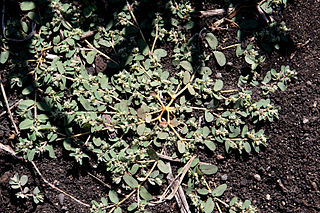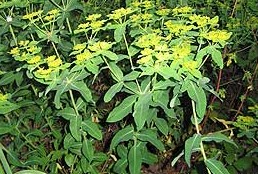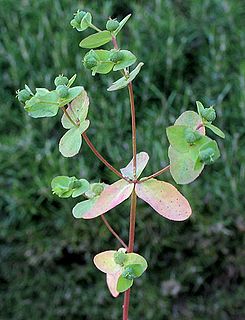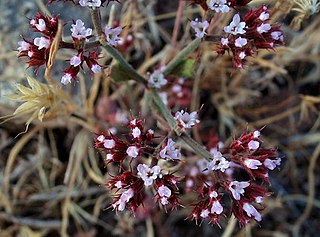
Euphorbia is a very large and diverse genus of flowering plants, commonly called spurge, in the spurge family (Euphorbiaceae). "Euphorbia" is sometimes used in ordinary English to collectively refer to all members of Euphorbiaceae, not just to members of the genus. Some euphorbias are commercially widely available, such as poinsettias at Christmas. Some are commonly cultivated as ornamentals, or collected and highly valued for the aesthetic appearance of their unique floral structures, such as the crown of thorns plant. Euphorbias from the deserts of Southern Africa and Madagascar have evolved physical characteristics and forms similar to cacti of North and South America, so they are often incorrectly referred to as cacti. Some are used as ornamentals in landscaping, because of beautiful or striking overall forms, and drought and heat tolerance.

Euphorbia esula, commonly known as green spurge or leafy spurge, is a species of spurge native to central and southern Europe, and eastward through most of Asia north of the Himalaya to Korea and eastern Siberia.

Euphorbia resinifera, the resin spurge, is a species of spurge native to Morocco, where it occurs on the slopes of the Atlas Mountains. The dried latex of the plant was used in ancient medicine. It contains resiniferatoxin, a capsaicin analog tested as an analgesic since 1997.

Euphorbia albomarginata, whitemargin sandmat or rattlesnake weed, is a small low-growing annual, in the spurge family native to desert, chaparral, and grassland habitats of southwestern North America, from southern and central California to Northern Mexico and Louisiana.

Euphorbia maculata, known as spotted spurge or prostrate spurge, the latter name not to be confused with Euphorbia prostrata, is a fast-growing annual plant in the family Euphorbiaceae, native to North America. It is a common garden and lawn weed in the United States.

Daphne laureola, commonly called spurge-laurel, is a shrub in the flowering plant family Thymelaeaceae. Despite the name, this woodland plant is neither a spurge nor a laurel. Its native range covers much of Europe and extends to Algeria, Morocco and the Azores. With Daphne mezereum it is one of two species of Daphne native to Britain, both of which have a strong preference for alkaline soils and are most commonly found in limestone areas, although D. laureola is also found on clay. However, unlike D. mezereum, D. laureola is an evergreen with yellowish green flowers borne very early in the spring and black berries, which are poisonous to humans but not to birds, present from late summer. All parts of the plants are poisonous. The sap is known to cause skin rashes on contact.

Collomia linearis is a species of flowering plant in the phlox family known by the common names tiny trumpet and slenderleaf collomia. This tiny wildflower is native to North America where it is fairly widespread across the north and west. It is an annual herb with a velvety erect stem bearing long, narrow green leaves. Atop the stem is a cluster of up to 20 white or light pink flowers, each about a centimeter across. Each has five small rounded petals and stamens tipped with anthers bearing white pollen.

Euphorbia corollata is an herbaceous perennial plant in the family Euphorbiaceae that is native to North America. A common name for the species is flowering spurge. It has a milky sap that can cause skin and eye irritation in some people. It grows up to 1 m (3 ft) tall, with smooth stems and light green leaves arranged alternately or in whorls. Leaves are about 10 mm wide and 75 mm (3 in) long. Each stem terminates in a panicle 20 to 25 mm across. Flowers are about 6 mm across and consist of one pistillate and several staminate flowers surrounded by five white bracts - not petals but formed from the involucre at the base of the flowers. Flowering spurge blooms from June to September.

Euphorbia dentata is a species of spurge known by the common names toothed spurge and green poinsettia. It is native to parts of North and South America, and is present elsewhere on the continents. Its true native range is uncertain. It is a noxious weed in some areas. This is a hairy annual herb with an erect or somewhat erect stem reaching anywhere from 20 to 50 centimeters tall. Its hairy, pointed leaves are a few centimeters long, widely to narrowly lance-shaped, and generally toothed. The inflorescence appears at the end of branches and contain cream or yellowish staminate or pistillate flowers just a few millimeters wide. The fruit is a lobed spherical or heart-shaped capsule about half a centimeter wide which contains three bumpy rounded seeds.

Euphorbia oblongata is a species of spurge known by the common names Balkan spurge, eggleaf spurge and oblong spurge. It is native to Eurasia but can be found elsewhere as a weedy introduced species. This is a hairy perennial herb growing to maximum heights of just over half a metre. It has oval-shaped or narrow leaves with finely toothed edges which are 4 to 6 centimetres long. The foliage is green to yellow-green. The inflorescences hold tiny glandular flowers. The fruit is a spherical capsule about half a centimetre long which contains smooth brown seeds.

Euphorbia serrata is a species of spurge known by the common names serrated spurge and sawtooth spurge. It is native to Europe but it is present elsewhere as a weedy introduced species. This is a perennial herb growing anywhere from 20 centimetres to about half a metre in height. The leaves are long and very narrow on most of the plant, with more oval-shaped leaves toward the tips of the stems. They are finely toothed. At the ends of the branches are inflorescences of tiny flowers. The fruit is a spherical capsule about half a centimetre wide containing tiny gray seeds.

Euphorbia spathulata is a species of spurge known by the common names warty spurge and roughpod spurge.

Chorizanthe staticoides is a species of flowering plant in the buckwheat family known by the common name Turkish rugging. It is endemic to California, where it is a common member of the flora in the chaparral and scrub habitats in a number of regions.

Euphorbia glauca, known by the common names of waiūatua, waiū-o-Kahukura, New Zealand sea spurge, or shore spurge, is a coastal plant endemic to New Zealand. It is in decline.
Euphorbia hooveri is a species of euphorb known by the common names Hoover's sandmat and Hoover's spurge. It is endemic to California, where it grows in the rare vernal pools of the Central Valley. Due to the elimination of most of its habitat, it became a federally listed threatened species in 1997.

Euphorbia melanadenia is a species of Euphorbia known by the common name red-gland spurge. It is native to the deserts and mountains of Baja California and southern California and Arizona, where it grows in dry, rocky habitat. It is a perennial herb forming a small clump or mat of very slender, tangling red stems. The stems are lined with pairs of slightly woolly oval-shaped leaves 2 to 9 millimeters wide. The tiny inflorescence is a cyathium less than 2 millimeters wide. The cyathium is a bell-shaped array of white, scalloped petal-like appendages surrounding the actual flowers. Each appendage has at its base a shiny red nectar gland. At the center of the appendages is a ring of male staminate flowers around a single female flower. The female flower develops into an oval-shaped fruit which bears wrinkled white seeds.

Euphorbia balsamifera is a flowering plant in the spurge family Euphorbiaceae. It is distributed from Arabian Peninsula to Sahara and Canary Islands. It is the vegetable symbol of the island of Lanzarote.

Euphorbia schizoloba is a species of euphorb known by the common name Mojave spurge. It is native to the southwestern United States, where it grows in desert hills and mountains. It is a perennial herb producing upright stems up to 40 centimeters tall, sometimes with coats of sparse hairs. The stems are lined with alternately arranged leaves which are oval with pointed tips and measure up to 2 centimeters in length. The inflorescence is a cyathium with bell-shaped bracts surrounding four tiny glands with flat, fringed appendages. At the center of this arrangement are several staminate flowers and one long pistillate flower.

Portulaca halimoides is a species of purslane known by the common name silkcotton purslane. It is native to the deserts of the southwestern United States and northern Mexico, as well as parts of Central and South America. It is a fleshy annual herb producing a branching stem spreading to a maximum length around 25 centimeters. It is often pink or red in color and there are strands of woolly hairlike trichomes at nodes along the stem and within the inflorescence. The thick, cylindrical, blunt-tipped leaves are up to 2 centimeters in length and green to red in color. Flowers occur in clusters of up to 10 at the tips of the stem branches. Each is a few millimeters wide with yellow petals which are sometimes hidden under the two fused, fleshy red sepals. The fruit is a tiny capsule which contains several seeds. The grainlike seeds may be black, grayish, or silvery in color.

Euphorbia virgata, commonly known as leafy spurge, wolf's milk leafy spurge, or wolf's milk is a species of spurge native to Europe and Asia, and naturalized in North America, where it is an invasive species.

















